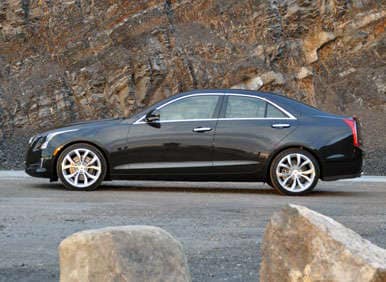Recent Articles
Popular Makes
Body Types
2013 Cadillac ATS 3.6 Road Test and Review
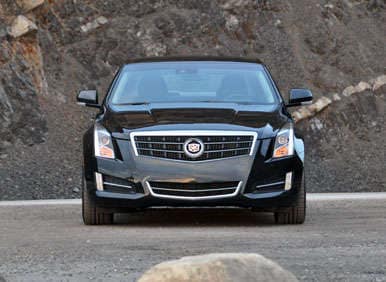
It is official. With the introduction of the 2013 Cadillac ATS, the luxury division of General Motors accomplishes two significant milestones. First, it can credibly market the new 2013 ATS as a standard of the world, if not quite the standard of the world. Second, it can now be forgiven for the horrid little Cimarron from the 1980s and the feeble Catera from the 1990s.
That’s right. Cadillac finally has a genuine entry-level luxury sport sedan. One that requires no apologies.
Does this make the Cadillac ATS a groundbreaking vehicle? For Cadillac, absolutely. For American luxury marques, indeed. But when measured against the depth and breadth of the class, the ATS simply meets what is a very high standard, following a standard template in terms of size, packaging, materials, and equipment.
2013 Cadillac ATS 3.6 Road Test and Review: Models and Prices
Cadillac sells the new 2013 ATS with a choice between three engines and in Standard, Luxury, Performance, and Premium trim levels. A modest 2.5-liter 4-cylinder engine is installed in the ATS 2.5, while the ATS 2.0 Turbo has a turbocharged 2.0-liter 4-cylinder. My test car was the ATS 3.6, powered by a 3.6-liter V-6 engine.
The least expensive path to ATS ownership is the 2.5 Standard model, which costs $33,990. The most expensive ATS 3.6 AWD Premium model starts at $48,690.
My test car was the ATS 3.6 Premium with rear-wheel drive, carrying a base price of $47,590. Black Diamond Tricoat paint and a Cold Weather Package with a heated steering wheel and heated front seats bumped the sticker price to $49,185.
Highlights from my test car’s standard equipment list include leather upholstery, front performance seats with power adjustment, a Cadillac User Experience (CUE) infotainment screen, a Bose premium surround sound audio system, Bluetooth connectivity with audio streaming, a navigation system, and a head-up display. Dual-zone automatic climate control is also included on the ATS 3.6 Premium model, as well as LED ambient lighting, passive entry with push-button starting, and adaptive remote vehicle starting.
Additionally, the ATS Premium models come standard with a number of safety-related features, for which I'll provide detail later in the review.
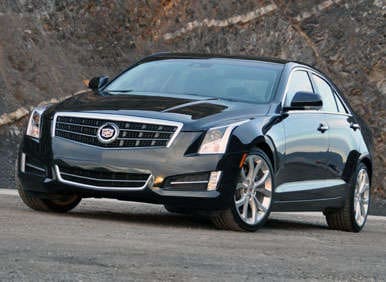
2013 Cadillac ATS 3.6 Road Test and Review: Design
- “New expression” of Cadillac Art & Science design language
- LED front signature lighting
- Active grille shutters
- Lightweight architecture employing high-strength steel and Martensitic alloys
- Hand-crafted “cut and sewn” interior materials
- Genuine wood, metal, or carbon fiber detailing
The new 2013 ATS is an attractive car with a distinctive appearance that’s instantly identifiable as a Cadillac. Every line sweeps cleanly into the sedan’s tapered tail, where the center brake light is deftly integrated as a spoiler and where signature vertical taillights are capped with hints of classic Cadillac fins. Dual exhaust outlets and a center reversing light are masterfully integrated into the rear diffuser panel.
If there’s a styling misstep, it rests with the cursive “Cadillac” script stamped into the spear of silver trim beneath the rear license plate. It looks like an afterthought, and is unnecessary.
Cadillac claims the ATS model’s interior is constructed using handcrafted cut-and-sewn materials combined with trim rendered in genuine wood, metal, or carbon fiber. My test car’s black-on-black cabin included real aluminum trim and magnesium paddle shifters, as well as fabric-wrapped roof pillars. Aside from the tilt/telescopic steering wheel’s plastic adjustment lever, which looked like it belonged in a Chevy Cruze, the ATS hid, for the most part, evidence of penny-pinching.
Unfortunately, with fewer than 5,000 miles on the odometer, my sample’s head-up display emitted a constant rattle on any pavement that wasn’t utterly smooth. If I reached forward and applied pressure to the trim surrounding the display, the rattle stopped.
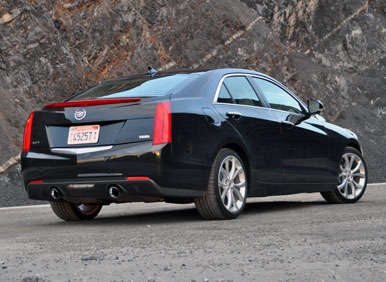
2013 Cadillac ATS 3.6 Road Test and Review: Comfort and Cargo
- Seats, steering wheel, pedals, and shifter specifically designed for “effortless and intuitive performance driving”
- Leatherette or leather upholstery
- 10.2 cu.-ft. trunk
Intimately sized, the compact ATS is not the Cadillac to buy if you’re looking for a roomy car in which to carry your pals and four sets of clubs to the course. The ATS is snug inside, tight, and equipped with a surprisingly small trunk. Yet, this car is still comfortable for the driver and a front seat passenger.
Let me set the stage for a moment. I am 45 years old, six feet tall, with a 33-inch inseam and a 40-inch waist. I could sit behind this Cadillac’s steering wheel and drive all day in total comfort. The driving position is perfection, and while getting into and out of the car isn’t easy, it isn’t quite difficult, either. The most significant impediment here is the location of the roof’s B-pillar in relationship to the driver’s seat.
The back seat, hopelessly optimistic in its three-abreast seating capacity, is best used to carry two people. Once I had squeezed through the V-shaped rear door opening and gingerly tucked my size-12 feet into the tiny foot well, I found that I could probably handle a cross-town trip of no longer than 45 minutes. The problem is that I suffer from a bit of claustrophobia, and I tend to be fidgety in the first place. The ATS model’s rear quarters are not a place where I could be happy for very long.
This Cadillac’s trunk is small, sized halfway between a Mazda Miata and a Nissan Altima. Plus, it is hideously trimmed using a material that resembles home insulation. Perhaps the good men and women toiling inside of the Renaissance Center, who have utterly nailed the bulls-eye in so many ways with the ATS, could be persuaded to cruise up Woodward to the Audi dealer in Birmingham to see how trunks are done.
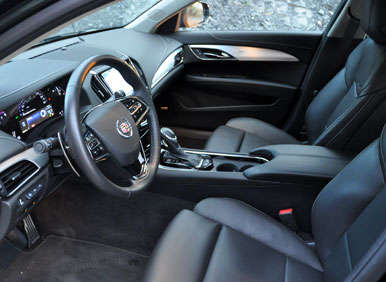
2013 Cadillac ATS 3.6 Road Test and Review: Features and Controls
- Cadillac User Interface (CUE)
This ATS is the third Cadillac I’ve driven in recent weeks that is equipped with CUE, a new touch-screen and touch-panel control interface for the climate system, the stereo system, the navigation system, and other vehicle features. Cadillac says the screen can be pinched, spread, and swiped similar to a smartphone or tablet screen, that the screen is proximity sensing, and that both the screen and touch-panel provide haptic feedback to confirm commands.
First, let me say that CUE is a commendable first-time effort from the company that once gave us the V-4-6-8 engine. It looks impressive, and it even works the way Cadillac says it will – sometimes.
I, however, am not a fan of the system. I’m a knobs and buttons guy. I’m a guy who prefers to look at the road instead of a proximity-sensing haptic-feedback touch panel when adjusting stereo volume, or changing cabin temperature, or changing satellite radio stations.
Nevertheless, I asked GM for a CUE demonstration just to make sure I understood the system’s capabilities. When this ATS was delivered, I received a walk-through of CUE’s features by a young man who was clearly an expert on the subject, and I was smugly amused by the system’s frequent lack of response to his jabbing, pinching, spreading, and swiping fingers. He admitted that in dry, winter weather, when fingertips are the epidermal equivalent of the Mojave Desert, CUE is sometimes unresponsive. And he also mentioned that Cadillac provides a micro-fiber cloth, located in the glove box, for clearing finger smudges from the CUE screen and piano-black touch panel.
You know what? With knobs and buttons, the controls always respond, and it doesn’t matter if my hands are dried out from the weather or not. I also don’t need to worry about wiping smudges off of knobs and buttons. And after a few hours behind the wheel, I don’t need to look away from the road to use knobs and buttons.
Beyond the issues of aesthetics and control response, my home state has fairly strict laws about using smartphones or tablets while driving. So why in the heck does Cadillac – or any other car manufacturer with a similar system and interface – think it is a good idea to install one of these things in a dashboard to control primary system functions? And in Cadillac’s case, to make it standard?
It is truly ironic that one of the best arguments in favor of automated cars and highways resides inside of the 2013 Cadillac ATS, one of the best driving cars on the market.
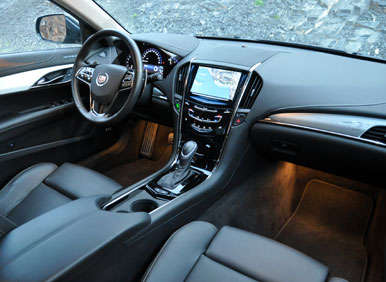
2013 Cadillac ATS 3.6 Road Test and Review: Safety and Ratings
- Driver Awareness Package
- Driver Assist Package
The 2013 ATS is offered with two option packages that add a number of new safety technologies that Cadillac hasn’t made available to consumers prior to this year.
The Driver Awareness Package is optional on the Luxury model and standard on the Performance and Premium models. It includes rain-sensing wipers, rear-seat side-impact airbags, a Forward Collision Alert system, a Lane Departure Warning system, and a Safety Alert Seat that vibrates when danger might be lurking.
The Driver Assist Package is optional on the Performance and Premium models equipped with an automatic transmission. It adds a full-speed-range Adaptive Cruise Control system, a Side Blind Zone Alert system, a Rear Cross-Traffic Alert system, Automatic Collision Preparation with Intelligent Brake Assist, and Front and Rear Automatic Braking.
My test car did not have the Driver Assist Package, and I agree that it’s strange to drive a modern luxury sport sedan wearing a window sticker just south of 50 grand that does not have a blind-spot warning system (Side Blind Zone Alert).
The Cadillac ATS receives a 5-star rating in every single NHTSA crash-test assessment. In terms of crashworthiness, it simply does not get better than that, and as this review is written the only competitor that matches the Cadillac’s performance in this regard is the Volvo S60.
The Insurance Institute for Highway Safety (IIHS) had not performed crash tests on the new Cadillac ATS as this review was published.
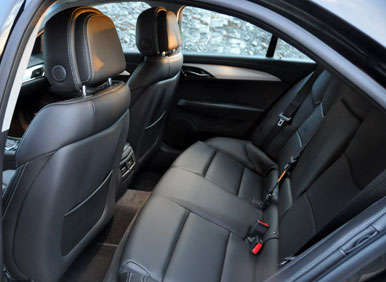
2013 Cadillac ATS 3.6 Road Test and Review: Engines and Fuel Economy
- Choice between 4-cylinder, turbocharged 4-cylinder, and V-6 engines
- Standard rear-wheel drive
- Optional all-wheel drive
A direct-injected, 2.5-liter 4-cylinder engine is standard in the 2013 Cadillac ATS, and it makes 202 horsepower at 6,300 rpm and 190 lb.-ft. of torque at 4,400 rpm. A 6-speed automatic transmission drives the rear wheels, and with just 3,315 lbs. to motivate, the engine likely delivers decent performance. That said, it is also likely to propel lease-deal specials and rental units, so let us know what you think of it the next time you’re upgraded into a luxury car at the airport.
Most ATS models sold to buyers who care about something other than the monthly payment will have a direct-injected, turbocharged 2.0-liter 4-cylinder or a 3.6-liter V-6 under the hood. The turbocharged four generates 272 horsepower at 5,500 rpm and 260 lb.-ft. of torque spread between 1,700 and 5,500 rpm. That torque spread means the turbocharged ATS feels responsive just about everywhere in the rev range, and those power ratings compare favorably to the BMW 328i.
My test car had the direct-injected 3.6-liter V-6 engine, with 321 horsepower at 6,800 rpm and 275 lb.-ft. of torque at 4,800 rpm. It was paired with a 6-speed automatic transmission and rear-wheel drive, rated to return 19 mpg in the city and 28 mpg on the highway. I extracted 18.3 mpg with an emphasis on city and spirited mountain driving.
The automatic transmission is equipped with Performance Algorithm Liftfoot (PAL) technology. When the car’s Magnetic Ride Control suspension is in Sport mode, software monitors lateral cornering force and automatically downshifts earlier and holds revs longer. The assumption is that the car is being driven with verve and that the driver will appreciate that the transmission is helping to supply engine braking entering a turn while providing the proper gear for a speedy exit from the turn. Gear changes are executed with greater speed, and the transmission matches revs on downshifts.
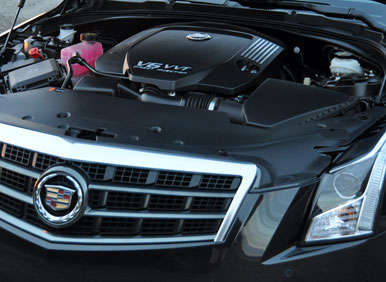
2013 Cadillac ATS 3.6 Road Test and Review: Driving Impressions
Dynamically, the Cadillac ATS 3.6 is an outstanding sport sedan. It never feels artificial, like software code is deciding that perhaps what you’re asking the car to do isn’t such a good idea. It never feels fatigued, like it is begrudgingly complying when the driver elects to tackle a final set of switchbacks. And it never fatigues its driver, fighting against inputs, reacting inconsistently to inputs, or behaving in a disharmonic fashion under imperfect circumstances.
The ATS 3.6 is a genuine thrill to drive, on par with the best from Germany in terms of its ability to accelerate, corner, stop, and most important of all, communicate. Commendably thin windshield pillars, a perfect driving position, and excellent steering with a wheel that’s terrific to grip combine to deliver uncanny accuracy and exceptional confidence.
I drove the ATS on a writhing ribbon of narrow, poorly-maintained, wet mountain road that I haven’t traveled in years – because this Cadillac is the kind of car that inspires such exploration – and no matter what the hillsides, Mother Nature, and the indifference of maintenance crews in California’s Ventura County threw at it, the ATS remained calm and carried on.
The 3.6-liter V-6 engine loves to rev, and while it can sound a bit whiny and feel a bit grainy from time to time, it delivers a powerful punch in the lightweight ATS. The automatic transmission provides paddle shifters and a manual shift gate with an intuitive shift pattern. I wished the paddles were mounted to the steering column instead of the steering wheel. We shuffle-steering drivers are like that.
Steering, handling, grip, and braking proved utterly faultless. This is an exceptionally balanced car, and driver inputs simply do not produce sudden or unexpected dynamic results. The ZF premium electric steering feels anything but electric, the Brembo front brakes are fantastic and free of fade, the performance suspension with Magnetic Ride Control dampers delivers an excellent balance between ride and handling, and the 18-inch summer performance tires provide exceptional grip. Cadillac says engineers developed the ATS on Germany’s famed Nürburgring, and it shows. The ATS is a brilliant driving machine.
Nothing, however, is perfect, and I have three minor suggestions for improvement. First, the suspension is a tad bit too stiff when cruising sectioned concrete freeways in Los Angeles. The ride quality is not jarring; just firm enough to continually remind the driver that the car’s mission is to deliver performance more than it is to deliver luxury. Second, the brake pedal could use a bit of extra progression and travel combined with a hint more feedback to make it feel more natural as the driver bleeds on and off of the pedal. Third, the transmission’s PAL often holds revs too long before upshifting.
None of these complaints should have Cadillac engineers scrambling back to the drawing table. Seriously, I am looking for any tiny little crack in the ATS model’s driving dynamics to avoid sounding as though a check from GM arrived in my mail.
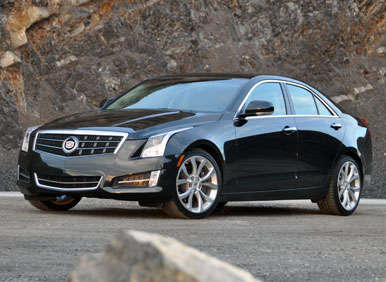
2013 Cadillac ATS 3.6 Road Test and Review: Final Thoughts
Dare I say that, purely from a driving enjoyment perspective, the Cadillac ATS is superior to an Audi A4, a BMW 3 Series, or an Infiniti G37, three of my favorite entry luxury sport sedans? No, not without comparing them back-to-back on the same roads. But I will say that it’s been awhile since I’ve driven a sedan that inspired me to drive just for the pure pleasure of driving. This Cadillac ATS 3.6 did exactly that, which cannot be said for the last BMW 328i that rolled into my driveway.
Combine this Cadillac's athletic capabilities with appealing and distinctive design, outstanding crash-test ratings, competitive prices, and more, and it absolutely deserves a slot on any entry-luxury sport sedan shopper's consideration list.
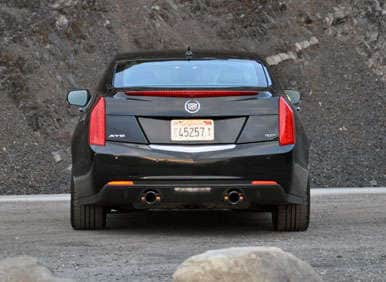
2013 Cadillac ATS 3.6 Road Test and Review: Pros and Cons
- Styling
- Engineering
- Driving dynamics
- Interior materials
- Safety technology
- Crash-test ratings
- CUE technology
- Small trunk
- Tight cabin
Cadillac supplied the vehicle for this review
2013 Cadillac ATS 3.6 photos by Christian Wardlaw
